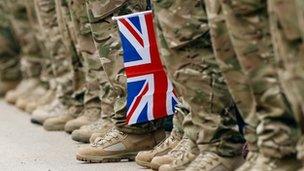Analysis: Army 2020 plan coherent but risky
- Published

Huge questions remain about how 5,000 new reservists will be recruited
Defence Secretary Philip Hammond has unveiled details of plans to restructure the Army by 2020, saying it will become a "forward-looking, modern fighting machine" as its number of regular soldiers is cut by 20,000. But what are the implications?
For all the confident predictions from Defence Secretary Philip Hammond and senior generals about the capabilities of what is being dubbed "Army 2020", the restructuring is prompted in large part by economics. As Mr Hammond himself put it: "We inherited a force that could not be sustained."
With combat operations due to end in Afghanistan in 2014, an opportunity has been seized to try to make a virtue of the financial pressures to restructure the force in a more logical way that, commanders believe, will still deliver the combat power the country needs.
First the cuts - five infantry battalions, two armoured regiments and 10 equivalents drawn from supporting units like artillery, engineers and the Army Air Corps. It's always cuts to the infantry battalions in particular that are the most controversial and the most painful, given long-standing regimental histories and traditions that have been carried forward down the centuries.
The Green Howards, for example, whose traditions are now borne by the 2nd Battalion the Yorkshire Regiment - among the battalions to be axed - was formed in 1688 and survived any kind of amalgamation until as recently as 2006.
Ministers insist that the decisions on which battalions are to go were made after an exhaustive study of recruiting data; demographic predictions; and wider considerations about the overall footprint of the military.
But of course politics intervenes and nowhere more so than in Scotland where a number of infantry battalions have problems recruiting up to their full strength. Only one Scottish battalion though is to go - many analysts believe this is an attempt by a London-based government to placate Scottish opinion as the controversial issue of devolution looms.
Overly ambitious?
Where Army 2020 is most ambitious in its approach - critics might argue overly ambitious - is in the place that it ascribes to the reserves. The Territorial Army is to be expanded significantly - doubled in size to 30,000 and given training and equipment on a par with the regulars.
As Philip Hammond put it, the reserves will no longer be "an add on to the Army, but a vital integrated component of the Army".
All well and good, but analysts stress that while individual reservists have performed creditably on operations, a glance at Britain's longer military history suggests this has not been one of the strongest elements of the British military tradition.
Lord Dannatt talks about how reservists will be mobilised
Army 2020 will require little short of a revolution in the way reserves are recruited, organised and deployed.
Huge questions remain about how so many new reservists will be recruited. How will employers be encouraged to release key individuals for lengthy periods of duty? And can the Army reach out to key sections of the community - ethnic minorities for example - without whom these ambitious reserve targets may not be achievable?
When the Army fully returns from Germany by 2020, the bulk of the British military will be based at home for the first time in generations. All of this will mean changing its geographic footprint - new bases will be needed, especially if regular and reserve units are to be twinned. This clearly will have significant costs.
Budget issues will continue to dog Army 2020 as they have dogged its predecessors. A better equipped reserve and better training standards will require funding. Modernising the equipment of the main fighting units for the reaction forces will cost too.
Mr Hammond clearly believes that he has headroom in the budget to do all this. But defence spending is still going to have to comply with the prevailing economic climate.
The new Army structure - on paper at least - looks coherent. It makes the best of the financial constraints to set out a new force for the unpredictable world facing the military post-Afghanistan. But some of its most novel features - its reliance upon reserves for example - are among its most risky.
One leading defence commentator described it as "a one-shot force" meaning that decisions on the circumstances of its deployment will have to be very carefully taken to ensure that its capabilities meet the challenges it faces. The implication being that Army 2020 will have very little left in the locker.
- Published5 July 2012
- Published5 July 2012
- Published5 July 2012
- Published5 July 2012
- Published3 July 2013
- Published3 July 2012